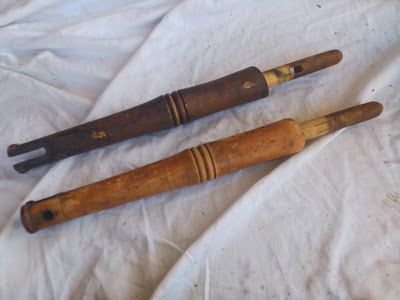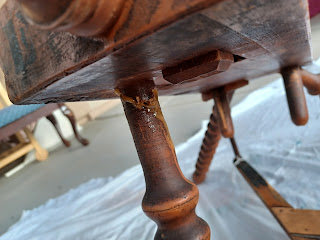here is a proper chronicle of my spinning wheel project, so far. the very, very beginning can be found over in this adoption post from June 23, 2022. (June 23 happens to be my half-birthday, so that's kind of cool. happy half-birthday to me, and happy re-birthday to this little old spinning wheel.)

after picking her up from the overcrowded workshop/store room at
Sharlot Hall Museum, I rushed to my local craft store to consult the guild's library, and then, with four borrowed reference books in my bag and a whole ton of uncertain excitement, I brought her home.
our two curious pugs watched suspiciously as I set her up in the living room, got to know all her pieces a little bit, and began wiping off the first layer of dust and dirt.
from my very first few photographs,
some helpful Ravelry folks expertly helped pinpoint a probable maker and time period (
more on that over here). I shall also share this post with the group and see if that helps narrow it down any further.
I've taken dozens more photos since then, you see.

I did get the flyer and bobbin taken apart eventually-- placing the metal orifice end in a padded vice gave me enough stability to firmly, gently twist the whorl off.
I'm hoping we can 3d-print a few more bobbins of the exact same size. having more than one would be nice.
that
first weekend, I spent almost all day Saturday cleaning the table, its legs, and just one of the wheel posts. Murphy's wood cleaner and fine #0000 steel wool did
most of the work once I figured out that combination was most effective against the caked-on black grime. (a note: wear gloves or something to protect your skin from the steel wool-- I got splintered by it a few times and learned that lesson.) I also employed a plastic kitchen scraper tool in spots where the grime was thickest. the hard plastic did chip through some of the paint-- but considering I hadn't known there was paint under all that dirt and soot and oil mess, I decided I didn't care too much.

for this wheel, I like the idea of preserving some of the character it's
acquired through so much use. not all the black grime is gone-- just most of it. the paint is not totally sanded away-- just very thin in spots.
after
all the cleaning, I oiled it with olive oil from our pantry. at some point I'll acquire just the right wood oil or polish to keep her in the best condition from now on.
the last piece I cleaned was the drive wheel itself. it seemed the filthiest, but also so delicate, with all those grooves and spokes to consider. in the end I scrubbed the outer wheel pretty well but mostly left the spokes alone. I didn't want to break or skew them or throw off the balance of the wheel in any way. even the wheel hub is still pretty black as a result.
but as I cleaned the outer part of the wheel, I discovered more evidence of repairs and patches. the white spots and scuffs here and there are wood filler or something like that, and the obvious circle areas (two on the outer wheel and one on the inside rim) are patches or plugs. I don't know enough about woodworking to understand what damage would require that sort of repair. it's interesting to see, though.
the cleaning done, a little light sanding done (with 400-grit sandpaper), and everything given a coat of oil, now all I need to do is...
1. replace one wheel post peg to (hopefully) stabilize the wheel better,
2. fit the drive band back on again, and
3. make sure I really understand the proper tensioning of this double-drive wheel system.
the other important consideration is her name. as this wheel settles in to my crafting life, what do I call her?
I turned to my family history for some inspiration. if this wheel is indeed from the 1860s or so, then I could name her after one of my great-grandmother's grandmothers. or perhaps after my grandmother's great-grandmother. at least half of the women in my family tree alive during that era seem to be named Sarah or Mary, but neither of those seems quite interesting enough.
I think either Lydia, (after Lydia Ann Taylor, 1852-1888) or Charlotte (after Charlotte Amelia Van Orden, 1828-1895), or Phoebe (after Phoebe Rebecca Reynolds, 1863-1922). since I did get this wheel from a museum named for a very different and differently-spelled Sharlot, maybe Charlotte is it.
perhaps I'll do some more family history and see which stories spark the most connection. or I'll just poll everyone to see what they think sounds the best.
























No comments:
Post a Comment